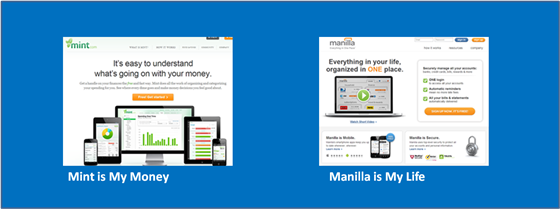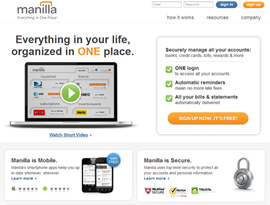This note is not about writing a review or a feature comparison chart since Manilla and Mint have very marked differences and, even though they seem to compete in the same space, they can actually be complimentary.
To read a review about Manilla please go here >>>
To read a review about Mint.com please go here >>>
To see a comparison chart between Mint.com and Manilla please go here >>>
What is the difference between Mint and Manilla?

Both companies provide web and mobile apps and both organize your financial information, but the main difference is how you relate to your providers.
In the case of Mint you have a complete view of your financial accounts including banks, brokers, insurance companies, and mutual funds. You can also budget, categorize transactions, set financial goals, and produce reports about your money so you make better decisions. It can be said that Mint centers around your money and it is very effective at that.
Manilla is centered around organizing your life regarding all your provider statements and bills. This not only includes your bank, broker, insurance, and mutual fund statements, but also your household bills like phone, utilities, cable, newspaper and magazine, and everything else “bills and statements” you get by mail or email. You can say that anything that has a due date can be organized by Manilla.
Manilla is so much centered around organization that you can even connect your daily deal payments due, like Groupon and LivingSocial, and household provider payments like handy-man, plummer, babysitter, and everything else non digital.

But, how do they connect you and your providers?
Mint analyses your finances and shows you ways to save by recommending products and services with lower fees or better ways to use financial services. To do this the company establishes relationships with financial providers and then they introduce their offers in the communications stream between Mint and you. This establishes a somewhat closed relationship where your providers talk to Mint, then Mint talks to you. Mint establishes itself as a new kind of middleman.
Although Manilla keeps all of your bills and statements forever, so you always have records of what you’ve spent, they do not delve into and analyze your accounts. Manilla also establishes a relationship with your providers, but then it connects them directly to you through the delivery of their bills and statements. This is implemented by letting all of their partners exclusively contact you with advice, recommendations, and offers each time you open their corresponding bills and statements.
In fact Manilla does not publish ads or offers by themselves, that is reserved to the providers that communicate directly with you. From your Manilla private page you can see what your providers have to say and you can decide to go to their websites if you want. Manilla establishes an open relationship between them, your providers and you.
So how are Mint and Manilla complimentary then?
Both models of relating with your providers are valid, sometimes you need to talk directly with them and sometimes it’s better for a “neutral advisor” to filter what might be a better offer.
Also, since Mint holds your historic information, you can track your money over time and you can work better on the financial aspect of your life.
Manilla, on the other hand, is much broader in that it helps you with all personal and household providers, and you can effectively track and be up-to-date with your weekly and monthly obligations.
Conclusion: In the future the two companies may decide to “invade” each other’s territory, but for now it is very convenient to use both.